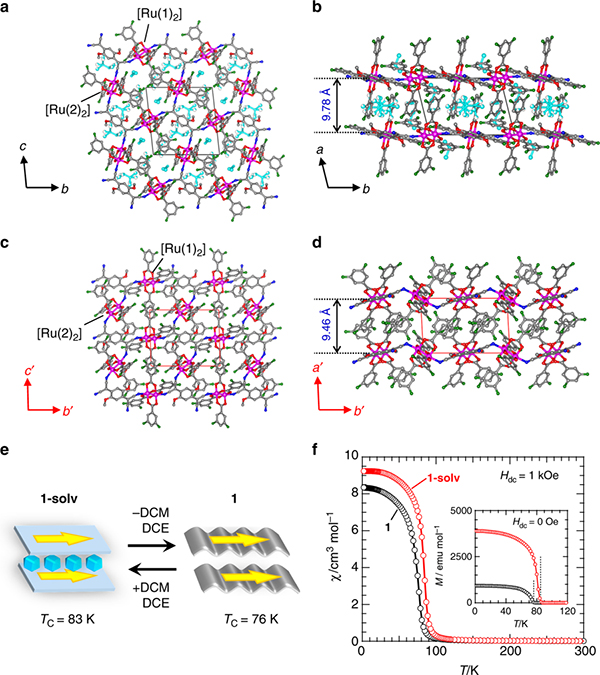Wataru KOSAKA, Zhaoyuan LIU, Jun ZHANG, Yohei SATO, Akihiro HORI, Ryotaro MATSUDA, Susumu KITAGAWA, Hitoshi MIYASAKA
Journal:Nature Communications
DOI:10.1038/s41467-018-07889-1
Published online: December 21, 2018
Press release online (in Japanese): PDF 1046KB

Structural modulation and magnetic sponge behavior upon solvation/desolation. a–d Views of the crystal structures of 1-solv (a, b) and 1 (c, d); figures a, c and b, d show projections along the a (a’) axis and c (c’) axis, respectively, where atoms N, O, C, F, and Ru are represented in blue, red, gray, green, and purple, respectively, and the crystallization solvents given in figures a and b are represented in cyan. The vertical inter-layer distance (l1) is indicated in blue digit in b and d, and the inter-unit translational distance (l2) corresponds to the a- or a′-lattice axis for each compound (Supplementary Table 8). The cell axes a′–c′ in c and d represent those for a transformed lattice(see Supplementary Methods), which were adopted for easy comparison with the lattice of 1-solv. e Schematic representation for the interchange between 1-solv and 1 upon solvation/desolvation, where the colored arrow indicates a plausible direction of ordered spins. f Temperature dependence of magnetic susceptibility (χ) for 1-solv (red) and 1 (black) measured under a 1 kOe dc field (Hdc) on field cooled process. Inset: Remnant magnetization (M) at Hdc = 0 Oe (heating process) measured after taking a FCM (1.8–120 K) under a 3 Oe dc field, where the dashed lines indicate the respective TC values(From Gas-responsive porous magnet distinguishes the electron spin of molecular oxygen)
